1772ss07
1772ss07.doc
EPA's ENERGY STAR Program in the Commercial and Industrial Sectors (Renewal)
OMB: 2060-0347
SUPPORTING STATEMENT FOR
INFORMATION COLLECTION REQUEST NUMBER 1772.07
“INFORMATION COLLECTION ACTIVITIES ASSOCIATED WITH EPA’S ENERGY STAR® PROGRAM IN THE COMMERCIAL AND INDUSTRIAL SECTORS”
January 20, 2016
Office of Air and Radiation
U.S. Environmental Protection Agency
TABLE OF CONTENTS
1. IDENTIFICATION OF THE INFORMATION COLLECTION 1
1(a) Title and Number of the Information Collection 1
1(b) Short Characterization or Abstract 1
2. NEED FOR AND USE OF THE COLLECTION 4
2(a) Need and Authority for the Collection 4
2(b) Practical Utility and Users of the Data 4
3. NONDUPLICATION, CONSULTATIONS, AND OTHER COLLECTION CRITERIA 5
3(b) Public Notice Required Prior to ICR Submission to OMB 5
3(d) Effects of Less Frequent Collection 7
4. THE RESPONDENTS AND THE INFORMATION REQUESTED 8
4(a) Respondents and SIC/NAICS Codes 8
5(b) Collection Methodology and Management 29
5(c) Small Entity Flexibility 29
6. ESTIMATING THE BURDEN AND COST OF THE COLLECTION 31
6(a) Estimating Respondent Burden 31
6(b) Estimating Respondent Costs 31
6(c) Estimating Agency Burden and Costs 31
6(d) Estimating the Respondent Universe 33
6(e) Bottom Line Burden Hours and Cost Tables 57
1. IDENTIFICATION OF THE INFORMATION COLLECTION
1(a) Title and Number of the Information Collection
This ICR is entitled “Information Collection Activities Associated with EPA’s ENERGY STAR® Program in the Commercial and Industrial Sectors,” ICR Number 1772.07, OMB Control No. 2060-0347.
1(b) Short Characterization or Abstract
The U.S. Environmental Protection Agency (EPA) created ENERGY STAR as a voluntary program to help businesses and individuals protect the environment through superior energy efficiency. The program focuses on reducing utility-generated emissions by reducing the demand for energy. In 1991, EPA launched the Green Lights Program to encourage corporations, state and local governments, colleges and universities, and other organizations to adopt energy-efficient lighting as a profitable means of preventing pollution and improving lighting quality. Since then, EPA has rolled Green Lights into ENERGY STAR for the commercial and industrial sectors and expanded ENERGY STAR to encompass organization-wide energy performance improvement, such as building technology upgrades, product purchasing initiatives, and employee training. At the same time, EPA has streamlined the reporting requirements of ENERGY STAR and focused on providing recognition incentives for improvements (e.g., ENERGY STAR Awards Program). EPA also makes tools and resources available over the Web to help the public overcome the barriers to evaluating their energy performance and investing in profitable improvements.
For several reasons, the public’s participation in the ENERGY STAR program for commercial and industrial sectors has continued to increase over the past several years, and EPA expects their participation to rise even more in the coming years. For example, President Obama and the U.S. Congress have made energy efficiency an important component of the federal government’s approach to energy management. In addition, the Energy Efficiency Improvement Act of 2015 congressionally mandates “Tenant Star,” a new recognition program within ENERGY STAR to improve energy efficiency in tenant-occupied spaces in commercial buildings.
In addition, a growing number of state and local governments are leveraging ENERGY STAR as a way for the public to respond to rising energy costs and global warming, including mandatory energy benchmarking and disclosure laws that require buildings within their jurisdiction to use EPA’s ENERGY STAR Portfolio Manager. Participation in ENERGY STAR has also risen dramatically because of the efforts of trade associations, utilities, and third-party providers in promoting the program to the public. These organizations voluntarily communicate ENERGY STAR messages and promote the use of ENERGY STAR tools and strategies in an effort to help companies reduce their energy consumption and find more environmentally friendly ways to conduct business.
As participation has increased, EPA has taken measures to reduce the burden on participants to take advantage of the benefits of ENERGY STAR. For example, EPA has expanded Portfolio Manager Web Services, which is one of several benchmarking methods available to users. Because Web Services integrates automated data collection and entry, it offers significant time savings advantages over the other methods; a benchmark using Web Services takes only about one-fifth the time of one conducted via manual entry.1 Over the past several years, EPA has seen a growing trend for users to opt for Web Services and thereby realize these savings. This is illustrated by the bar graph below, which shows the total number of benchmarks performed annually using Web Services and the other methods. In 2009, 41% of all benchmarks were performed using Web Services. By 2014, this had grown to 59%.

In addition to expanding Web Services, the Agency completed a comprehensive upgrade of Portfolio Manager, allowing participants to enter and retrieve information more quickly, and vastly simplified the process of entering building data in the National Building Competition so participants can register portfolios of buildings with just a few clicks.
As a result of the efforts of Partners and others under the ENERGY STAR Program, there have been significant benefits to the public and environment. For example, EPA estimates that, in 2013, the energy efficiency efforts of commercial buildings helped to avoid 96.0 million metric tons of carbon dioxide equivalent (MMTCO2e) of greenhouse gases and a net $7.7 billion (2013$). The efforts of industry helped to prevent another 39.7 MMTCO2 e of greenhouse gases and achieve a net savings of $2.2 billion (2013$).2 Typically, ENERGY STAR buildings use 35% less energy and emit 35% less greenhouse gases than average buildings. By the end of 2013, more than 22,000 buildings and plants representing more than three billion square feet of space had earned ENERGY STAR certification.3
This ICR examines the information collections under the ENERGY STAR Program in the commercial and industrial sectors. Sections 1 through 5 of this document describe the collections (e.g., from the standpoint of need and use/utility of the information collected). The sections also describe respondent and Agency activities. In Section 6, EPA estimates the total annual hour and cost burden to respondents and the Agency under the collections.
2. NEED FOR AND USE OF THE COLLECTION
2(a) Need and Authority for the Collection
ENERGY STAR is authorized under section 103(g) of the Clean Air Act. The Energy Policy Act of 2005 further provides authorization to EPA and the U.S. Department of Energy (DOE) to establish a voluntary program to identify and promote energy‑efficient products and buildings in order to reduce energy consumption, improve energy security, and reduce pollution through voluntary certification of, or other forms of communication about, products and buildings that meet the highest energy conservation standards. ENERGY STAR is a voluntary program aimed at preventing pollution rather than controlling it after its creation. Information is needed from organizations joining the program for identification purposes (e.g., contact information) and for establishing their partnership. Further, ENERGY STAR’s online tools (e.g., Portfolio Manger) are needed for users to benchmark facility energy performance, assess energy management goals over time, and identify strategic opportunities for savings and recognition opportunities. Finally, information is needed from organizations seeking ENERGY STAR recognition so that EPA can evaluate and verify their accomplishments and share their lessons learned with the public.
2(b) Practical Utility and Users of the Data
EPA uses information from organizations joining the program to ascertain basic identification information about them and verify their commitment to the program. EPA may also use partnership information for program implementation purposes, such as maintaining up-to-date listings of products and services available to the public. Further, ENERGY STAR’s online tools (e.g., Portfolio Manager, Energy Performance Indicator) are used by the public to benchmark facility energy performance and identify opportunities for improvements. Finally, EPA uses information from organizations seeking recognition to evaluate and verify their energy performance and accomplishments. For example, EPA offers the public an opportunity to display the ENERGY STAR on their buildings if they meet certain energy performance criteria defined by EPA. To be approved to receive the ENERGY STAR, buildings must demonstrate that they meet specific eligibility requirements as well as industry standards for comfort and indoor air quality. EPA recognition enhances the image of organizations as national leaders in energy performance.
3. NONDUPLICATION, CONSULTATIONS, AND OTHER COLLECTION CRITERIA
3(a) Nonduplication
The information collected under this ICR is not collected by any other EPA office or by any other federal agency. Therefore, there is not a potential for duplication with other federal collections.
3(b) Public Notice Required Prior to ICR Submission to OMB
In compliance with the Paperwork Reduction Act of 1995, EPA solicited public comments on this ICR through an announcement in the Federal Register on July 23, 2015 (80 FR 43770). No comments were received.
3(c) Consultations
In December 2015, EPA contacted three Partners to request their comments on key burden estimates and statements in this ICR. The purpose of the consultations was to determine if the burden estimates (e.g., for use of Portfolio Manager) should be updated or revised in preparing ICR 1772.07. EPA selected one commercial real estate, one retail and one K-12 schools Partner, as they represent the three most active sectors in the program. The table identifies the points of contact (POCs) and their organizations.
POC Name |
Organization Name |
Phone Number |
|
Katie Ross |
Cushman & Wakefield |
-- |
|
Thomas Schneider |
North Penn School District |
215-853-1140 |
|
Andrew Thorsen |
Kohl's Department Stores |
262-703-1077 |
3(d) Effects of Less Frequent Collection
EPA has carefully considered the information collection burden under the ENERGY STAR Program. EPA is confident that those activities requested of respondents are necessary, and to the extent possible, the Agency has minimized the burden. A number of the requested activities, for example, will be performed once (e.g., one-time submittal of a Partnership Agreement). In addition, respondents can satisfy many of the collections in this ICR by submitting readily available information. For example, users of Portfolio Manager are asked to enter energy use data (e.g., data from their energy bills). EPA believes strongly that, if the information collections in this ICR are not performed at the requested frequency, EPA’s ability to implement the ENERGY STAR Program and the public’s ability to benefit from the program’s tools and resources could be hampered significantly.
3(e) General Guidelines
Information collections performed under this clearance will follow all of OMB’s General Guidelines regarding federal data collection.
EPA intends to omit the expiration date from all forms being submitted for OMB review in this ICR. The information collected on the forms is modified infrequently. Since inclusion of the expiration date on the forms in these circumstances provides little to no value for the public, EPA intends to omit it from the forms.
3(f) Confidentiality
Participation in the ENERGY STAR Program is voluntary and may be terminated by participants or EPA at any time. If a claim of confidential business information (CBI) is asserted, EPA will manage that information in accordance with EPA’s provisions on confidentiality. 40 CFR Part 2, Subpart B establishes EPA’s general policy on the public disclosure of information and procedures for handling CBI claims.
3(g) Sensitive Questions
No questions of a sensitive nature are asked of participants with ENERGY STAR.
4. THE RESPONDENTS AND THE INFORMATION REQUESTED
4(a) Respondents and NAICS Codes
Following are the North American Industry Classification System (NAICS) codes of respondents most likely carrying out the information collections under this ICR.
Industry Sectors |
NAICS Code(s) |
Agriculture, Forestry, Fishing and Hunting |
11 |
Mining, Quarrying, and Oil and Gas Extraction |
21 |
Utilities |
22 |
Construction |
23 |
Manufacturing |
31-33 |
Wholesale Trade |
42 |
Retail Trade |
44-45 |
Transportation and Warehousing |
48-49 |
Information |
51 |
Finance and Insurance |
52 |
Real Estate and Rental and Leasing |
53 |
Professional, Scientific, and Technical Services |
54 |
Management of Companies and Enterprises |
55 |
Administrative and Support and Waste Management and Remediation Services |
56 |
Educational Services |
61 |
Health Care and Social Assistance |
62 |
Arts, Entertainment, and Recreation |
71 |
Accommodation and Food Services |
72 |
Other Services (except Public Administration) |
81 |
Public Administration |
92 |
4(b) Information Requested
This section describes the information collections under this ICR, including data items and respondent activities. The section also identifies the sector (i.e., private and/or public sector) that is expected to carry out each collection (see the heading introducing each collection).
.
JOINING THE ENERGY STAR PROGRAM AND RELATED ACTIVITIES
Organizations interested in joining the ENERGY STAR Program may be asked to submit a Partnership Letter or Agreement. They also may be asked to undertake related activities, as described below.
Commercial and Industrial Sector Partners (Private and Public Sector)
In order to join ENERGY STAR, organizations in the commercial and industrial sectors are asked to complete and submit a Partnership Agreement to EPA.4 These Partners agree to measure and track the energy performance of their organization’s facilities where possible by using tools such as those offered through ENERGY STAR; develop and implement a plan consistent with the ENERGY STAR Energy Management Guidelines to achieve energy savings; help spread the word about the importance of energy efficiency to their staff and community; and highlight their achievements with recognition offered through ENERGY STAR.
(i) Data items
A Partnership Agreement that includes the following information:
- Organization’s name;
- Contact information on organization’s Chief Executive;
- Contact information on organization’s Energy Manager;
- Contact information on organization’s Communications Contact (if applicable);
- Description of organization’s primary business or function (i.e., a checklist);
- Total amount of building/facility square footage owned, leased, and/or managed; and
- Brief explanation of how organization learned about ENERGY STAR.
Energy Management Plan.
(ii) Respondent activities
To join ENERGY STAR, organizations are asked to:
Complete and submit the Partnership Agreement online; and
Respond to EPA follow-up questions, if any.
Partners may prepare and follow an energy management plan.
Service and Product Providers (Private Sector)
An organization must meet certain eligibility requirements before applying to become a Service and Product Provider (SPP) Partner.5 Applicants must demonstrate that they have actively used the ENERGY STAR approach to help clients achieve their energy management goals as specified.
SPPs serving the existing commercial buildings market must benchmark at least 10 client commercial buildings in the last 12 months using Portfolio Manager and/or earn the ENERGY STAR certification for at least one client commercial building using Portfolio Manager and meet other program requirements. [Note that this ICR addresses benchmarking activities in the section, “Benchmarking,” under the heading, “Portfolio Manager.” This ICR addresses earning the ENERGY STAR in the section, “Recognition,” under the heading, “ENERGY STAR Certification.”]
SPPs serving the commercial new construction market must submit commercial building design projects that achieve Designed to Earn the ENERGY STAR. Eligible design projects are determined by using Target Finder and require approval from EPA. [Note that this ICR addresses applying for the Designed to Earn the ENERGY STAR in the section, “Recognition,” under the heading, “Designed to Earn the ENERGY STAR.”]
SPPs serving the industrial market must work with an ENERGY STAR industrial Partner on at least one energy efficiency project in the last two years and submit a Teaming Profile to EPA outlining the project scope and resulting savings for that project.
SPPs interested in joining ENERGY STAR complete and submit a Partnership Agreement to EPA using an online system. The Partnership Agreement requests SPP company information, contact information, and select pieces of information to enable automated verification that Partnership requirements have been met. The Partnership Agreement also lays out Partner commitments, disclaimers, procedures for dispute resolution, and other issues.
On an annual basis, SPPs may be asked to update contact information (i.e. contact name, phone, email) displayed on select Service and Product Provider listings on the Web site and to maintain quality of contact mailing lists.
(i) Data items
A Partnership Agreement to be completed and submitted online that includes the following information:
- Applicant company name;
- Information about the company, such as Web address and markets/sectors that the organization serves;
- Name, title, and contact information of the primary contact, communications contact, and signatory of the Partnership Agreement; and
- For Existing Commercial Buildings SPPs only, information about SPP activities over the past 12 months (i.e., Portfolio Manager building ID numbers to complete automated verification of activity); or
- For architecture firms only, information about Commercial New Construction SPP activities (i.e., Designed to Earn the ENERGY STAR of project achieving Designed to Earn the ENERGY STAR); or
- For Industrial SPP only, information about SPP activities (i.e., Teaming Profile outlining the project scope and resulting savings for that project).
Additional communications items that SPP Partner may elect to submit:
- One-page success story for Web site posting to demonstrate successful projects or relationships with commercial and institutional clients, or exemplary use of ENERGY STAR tools.
- Communications about SPP efforts for feature in quarterly newsletters or other medium, at EPA discretion.
(ii) Respondent activities
To join ENERGY STAR, organizations are asked to:
Complete and submit the Partnership Agreement online; and
Complete and submit requested materials for the appropriate Partnership category (e.g., Statement of Energy Design Intent, Teaming Profile), online.
SPP Partners are asked to:
Update contact information as needed by notifying program account manager of any changes and/or using the “My ENERGY STAR Account” tool; and
Communicate efforts and successes to ENERGY STAR and the broader market through success stories and other communications.
Energy Efficiency Program Sponsors (Private and Public Sector)
Energy Efficiency Program Sponsors (EEPS) interested in joining ENERGY STAR are asked to complete and submit a Partnership Agreement.6, 7 They commit to promote and use ENERGY STAR in a manner consistent with the national ENERGY STAR efforts and specifically agree to follow all applicable terms and conditions governing the use of the ENERGY STAR logos, which are registered trade and service marks. Some Partners will be asked on an annual basis to update organization and contact information displayed on the ENERGY STAR Web site and the Directory of Energy Efficiency Programs (DEEP). The Partners also agree to promote energy efficiency as an easy and desirable option for organizations and consumers to prevent pollution, protect the global environment, and save on energy bills.
(i) Data items
A Partnership Agreement.
Updates to organization and contact information displayed on the ENERGY STAR Web site and the Directory of Energy Efficiency Programs (DEEP).
Information to promote energy efficiency as an easy and desirable option for organizations and consumers to prevent pollution, protect the global environment, and save on energy bills.
(ii) Respondent activities
To join ENERGY STAR, organizations are asked to complete and submit a Partnership Agreement.
EEPS also agree to:
- Update organization and contact information displayed on the ENERGY STAR Web site and the Directory of Energy Efficiency Programs (DEEP) annually; and
- Provide information to promote energy efficiency as an easy and desirable option for organizations and consumers to prevent pollution, protect the global environment, and save on energy bills.
Small Business Network (Private Sector)
A small business may join the Network of small businesses working with ENERGY STAR. To join, they would provide requested information at EPA’s ENERGY STAR Web site. They would pledge to buy ENERGY STAR equipment and upgrade the energy efficiency of their facilities whenever financially viable. As part of the Network, they may use the ENERGY STAR promotional mark in accordance with the ENERGY STAR identity guidelines.
In addition, EPA may contact a small number of businesses to request input for the development of success stories.
(i) Data items
Information requested at EPA’s ENERGY STAR Web site:
- Information on type of small business (e.g., auto dealership, grocery);
- Contact information;
- Size of facility (in square feet) and number of employees/members;
- Indication of whether the facility is owned or rented; and
- Indication of how the small business heard about ENERGY STAR.
Input for success stories.
(ii) Respondent activities
Small businesses perform the following activities:
Provide requested information at EPA’s Web site; and
Provide input to EPA for success stories, if requested.
BENCHMARKING
Assessing energy use is a critical component of the ENERGY STAR Program and guidance provided by EPA to Partners. EPA provides tools to track, measure and compare energy use for a range of building types and facilities. Portfolio Manager is the primary tool for undertaking these activities and is available online, although for specific industry types, spreadsheet calculators may be provided.
Portfolio Manager (Private and Public Sector)
Portfolio Manager is an interactive energy management tool that allows users to track and assess energy and water consumption across their entire portfolio of facilities in a secure online environment. Users enter energy consumption and cost data into their Portfolio Manager account to benchmark facility energy performance, assess energy management goals over time and identify strategic opportunities for savings and recognition opportunities. A “benchmark” is defined as a measurement of a facility’s energy performance resulting from entering facility information and at least 12 consecutive months of facility energy data into EPA’s Portfolio Manager. Portfolio Manager offers multiple types of benchmarks: the 1-100 ENERGY STAR energy performance score for select commercial facility types, site and source Energy Use Intensity (EUI) for all commercial facility types, weather normalized energy values, greenhouse gas emissions, water consumption, and annual energy and water costs.
The ENERGY STAR scale accounts for the impacts of year‑to‑year weather variations, as well as facility size, location, and several operating characteristics. Portfolio Manager helps the user update and track data over time to continuously monitor performance. The user can use both short and long term trends in energy performance to make budget and management decisions regarding investments in energy‑related projects.
In addition, EPA intends to collect information from Portfolio Manager users on its usability as a Web-based tool and on the effectiveness of Portfolio Manager guidance. Based on this information, EPA will identify and make needed improvements.
(i) Data items
Information entered into Portfolio Manager:
- Contact information;
Facility data (e.g., name, address, year constructed);
- Facility operating characteristics (e.g., gross facility area, number of occupants, operating hours, number of PCs);
- Energy use information (e.g., meter name, usage data);
- Water use information (e.g., meter name, usage data); and
- Solid waste management/disposal (e.g. meter/waste type name, disposal quantity).
Information provided to EPA on the usability of Portfolio Manager and effectiveness of guidance.
(ii) Respondent activities
Organizations using the benchmarking feature of the Portfolio Manager system perform the following activities:
- Review the instructions of Portfolio Manager and set up account;
- Gather facility and energy data; and
- Enter the data into Portfolio Manager.
[Note: Users have several options for entering facility and energy data into Portfolio Manager. These options and associated burden are described in Section 6(d) of this document.]
Organizations may be asked to respond to EPA questions on the usability of Portfolio Manager.
Organizations may be asked to respond to EPA questions about guidance or trainings on benchmarking.
ENERGY STAR Energy Performance Indicator and Related Systems (Private Sector)
EPA gives industrial companies the opportunity to measure the energy efficiency of their plants and earn recognition for superior energy performance. To measure efficiency and improve energy use in the company, a company enters basic information about its plant (e.g., energy consumption data) into a spreadsheet tool called the Energy Performance Indicator (EPI), which can be downloaded from EPA’s ENERGY STAR Web site. The EPI produces a plant percentile score between 1 and 100 and compares that score to the most energy‑efficient plants in the industry and to the previous performance for the plant.
In addition, EPA has established a tool, the ENERGY STAR Challenge for Industry, which encourages companies to track their energy performance using a tracking system, such as Portfolio Manager, a spreadsheet-based tracking tool that can be downloaded from the ENERGY STAR Web site called the ENERGY STAR Energy Tracking Tool (ETT), or a company’s in-house tracking system.
Companies can enter basic information into the system to track their performance to advance energy management efforts. Only companies seeking recognition submit outputs from using the EPI or other tracking system to EPA.
(i) Data items
Information entered into the EPI or alternative tracking system:
- Plant characteristics; and
Energy consumption.
(ii) Respondent activities
Organizations enter information into the EPI or alternative system.
Data Collection for Model Development and Beta Testing (Private and Public Sector)
Occasionally during the development or testing of a score, EPA may collect information about annual energy use (one year’s worth of energy data), along with basic information about facility operations, such as the operating hours or number of workers.
(i) Data items
Information collected from participating organizations:
- Contact information;
- Facility data (e.g., name, address, year constructed);
- Facility operating characteristics (e.g., gross facility area, number of occupants, operating hours, number of PCs);
- Energy use information (e.g., meter name, usage data); and
- Water use information (e.g. meter name, usage data).
(ii) Respondent activities
Organizations may be asked to:
- Review the instructions of Portfolio Manager or spreadsheet;
- Gather facility and energy data; and
Enter the data into Portfolio Manager or spreadsheet.
RECOGNITION
ENERGY STAR Certification (Private and Public Sector)
Buildings (Private and Public Sector)
EPA offers the public an opportunity to display the ENERGY STAR on their buildings if they meet certain energy performance criteria defined by EPA. The online application for the ENERGY STAR is submitted through EPA’s benchmarking tool, Portfolio Manager. To be approved to receive the ENERGY STAR, buildings must meet specific eligibility requirements as well as industry standards for comfort and indoor air quality. A Professional Engineer or Registered Architect must verify that these requirements have been met and complete a Data Checklist (stamped/embossed and signed). [Note that this ICR addresses applicant benchmarking activities in the section, “Benchmarking,” under the heading, “Portfolio Manager.”]
EPA encourages certified buildings to submit building profiles for publication on the ENERGY STAR Web site to educate the public and promote their achievements. These profiles are not needed for certification, but are pursued voluntarily by about 5% of certified buildings.
In addition, EPA conducts audits on a small percentage of applications for quality control purposes. EPA confirms, for example, the accuracy of the information provided in the application for the ENERGY STAR, and may request facility documentation.
EPA also expects to periodically contact representatives of buildings that have earned the ENERGY STAR to collect information about the characteristics of buildings that lead to top energy performance. This includes information on the buildings’ construction, equipment used in the buildings, building management, and involvement in ENERGY STAR. EPA will use this information to better understand the specific design, construction, and operating characteristics of ENERGY STAR certified buildings and how these characteristics contributed to the buildings’ top energy performance. In addition, EPA intends to collect information about the qualification process to measure how easy it is for organizations to use. EPA needs this information to identify and make improvements to the process that buildings use to qualify for the ENERGY STAR.
(i) Data items
Application for ENERGY STAR certification consisting of a Data Checklist.
Information requested by EPA as part of its application review or quality control audit.
Profile of certified building for publication on the ENERGY STAR Web site (optional).
Information provided to EPA for analysis of ENERGY STAR certified buildings.
(ii) Respondent activities
Organizations applying for the ENERGY STAR perform the following:
- Engage a Professional Engineer or Registered Architect to conduct a facility data review, complete and stamp the application;
- Submit the online application consisting of a Data Checklist to EPA and respond to EPA questions if any; and
- Prepare and submit certified building profile (optional).
Some organizations may be asked to provide information as part of a quality control audit performed by EPA on a small percentage of applications.
ENERGY STAR certified buildings may be asked to respond to EPA questions for analysis of ENERGY STAR certified buildings.
Plants (Private Sector)
Industrial companies have an opportunity to earn the ENERGY STAR certification for specific types of plants that meet EPA’s energy efficiency criteria. If the plant’s Energy Performance Indicator (EPI) score is in the top quartile of the industry’s energy performance scale, the company can choose to apply for the ENERGY STAR certification by inputting the necessary data into the EPI and printing out a Statement of Energy Performance (SEP). A Professional Engineer (PE) verifies, signs, and stamps the SEP, and completes the PE Verification Checklist. The EPI, certified SEP, PE Verification Checklist, Plant Award Specification Sheet, and Plant Award Application Letter are sent to EPA. If the submittal contains confidential business information (CBI), the company sends the information to EPA’s contractor to verify energy performance results. If approved by EPA, the plant receives the ENERGY STAR certification. [Note that this ICR addresses participants’ entering data into the EPI in the section, “Benchmarking,” under the heading, “ENERGY STAR Energy Performance Indicator and Related Systems.”]
EPA also asks these companies to submit a profile of their certified plant that describes how the plant improved its energy performance and obtained recognition. This submission is optional.
(i) Data items
Energy Performance Indicator (EPI).
Statement of Energy Performance.
PE Verification Checklist.
Plant Award Specification Sheet.
Plant Award Application Letter.
Profile of certified plant. This is optional.
(ii) Respondent activities
Organizations using the EPI complete and submit the materials to EPA.
These organizations may also prepare and submit a profile of certified plant. This is optional.
ENERGY STAR Challenge for Industry (Private Sector)
EPA has established a tool, the ENERGY STAR Challenge for Industry, which encourages companies to pledge to reduce the energy intensity of their sites by 10% within five years and track their progress towards this goal using a tracking system (e.g., company in-house tracking systems, Portfolio Manager, ETT). Sites that achieve a 10% reduction in energy intensity within five years of their baseline have the opportunity to apply for recognition from EPA. The company must register the site’s baseline with EPA using an online registration form. The site can then complete an online recognition application and print out a Statement of Energy Improvement (SEI). A Professional Engineer (PE) verifies, signs, and stamps the SEI, and completes a PE Verification Checklist, which are both then sent via email to EPA. If approved by EPA, the site receives recognition (e.g., a certificate, congratulatory letter to the CEO). [Note that this ICR addresses participants’ entering data into their tracking systems in the section, “Benchmarking,” under the heading, “ENERGY STAR Energy Performance Indicator and Related Systems.”]
In addition, EPA may ask companies that achieve the ENERGY STAR Challenge for Industry to submit a plant profile that describes how they reduced their energy intensity and obtained recognition, which the EPA posts on its Web site to educate the public. This submission is optional.
(i) Data items
Industry Registration Form.
Industry Recognition Application.
Statement of Energy Improvement.
PE Verification Checklist.
Plant profile. This is optional.
(ii) Respondent activities
Organizations seeking recognition under the ENERGY STAR Challenge for Industry perform the following:
- Prepare and submit the registration form; and
- Prepare and submit the recognition application, SEI and PE Verification Checklist to EPA.
Organizations may also prepare and submit profiles of plants that achieve the Challenge for Industry. This is optional.
Designed to Earn the ENERGY STAR (Private Sector)
To seek Designed to Earn the ENERGY STAR (DEES) recognition, an organization is asked to become an ENERGY STAR Partner as an initial step. [Note that this ICR addresses organizations’ becoming a Partner in the section, “Joining the ENERGY STAR Program and Related Activities,” under the heading, “Commercial and Industrial Sector Partners.”] Then, an organization can enter information into EPA’s online tool, Portfolio Manager, and follow simple user prompts to save and generate information needed for the application. The tools can be used to obtain an ENERGY STAR score of 1 – 100 to determine if the design project’s estimated annual energy use meets criteria for DEES recognition.
The organization can generate a Statement of Energy Design Intent (SEDI). The SEDI is printed, stamped and signed by a Registered Architect or Professional Engineer (licensed professional). In addition, Letters of Intent are prepared by the Architect of Record (AOR) and building owner (for commercial new construction).
The SEDI, Letters of Intent from the AOR and building owner (for commercial new construction), and an optional Design Profile are submitted to EPA as the DEES application. Once the application is approved, EPA will email instructions to organizations meeting the DEES recognition criteria so they can download the DEES graphic.
(i) Data items
Data entered into Portfolio Manager (e.g., property use data).
Statement of Energy Design Intent.
Letters of Intent from AOR and Building Owner (for commercial new construction).
Design Profile (optional).
[Note: Organizations seeking recognition for commercial new construction design projects are asked to submit all of the data items above. Organizations seeking recognition for multifamily high rise new construction design projects are asked to submit the data items above, except for the Letters of Intent from the AOR and building owner; they also are asked to submit additional documents.8 These additional documents are addressed in EPA ICR 2060-0586, “EPA’s ENERGY STAR Program in the Residential Sector.”]
(ii) Respondent activities
Organizations submitting a DEES application perform the following activities:
Review application instructions and create account in Portfolio Manager, if needed;
Gather design data and estimated annual energy use data;
Enter the data into Portfolio Manager;
Complete and submit DEES application consisting of SEDI and, for commercial design projects, Letters of Intent from the Architect of Record (AOR) and building owner to EPA; and
Complete and submit a Design Profile (optional).
ENERGY STAR Awards (Private and Public Sector)
Organizations interested in receiving recognition for their efforts in improving their energy performance may apply for an ENERGY STAR Award. EPA currently issues awards to Commercial and Industrial (C&I) Sector Partners, Service and Product Providers (SPPs), and Energy Efficiency Program Sponsors (EEPS).
(i) Data items
Information provided by C&I Partners:
- General information (e.g., contact information, address, signed/dated); and
- Description of the following:
Management practices (e.g., best practices for managing energy).
Organization-wide improvements in energy performance.
Efforts in promoting and communicating success.
Information provided by SPPs:
- General information (e.g., contact information, address, and signed/dated certification); and
- Description of the following:
Organization and Business Practices.
Benchmarking and Certification (Existing Buildings).
Benchmarking and Certification (Design Projects).
Marketing and Recognition.
Information provided by EEPS:
- General information (e.g., contact information, address, and signed/dated certification); and
- Description of the following:
Category(-ies) that the EEPS program is designed to address (e.g., energy improvements in the C&I sector).
Program design (e.g., in terms of goals).
How ENERGY STAR has been incorporated into the Partner’s initiative.
Market effects resulting from Partner’s efforts.
Data sources used to support market claims.
(ii) Respondent activities
Organizations that apply for an award are asked to:
- Review the instructions; and
Complete and submit the information online.
National Building Competition (Private and Public Sector)
Through the ENERGY STAR National Building Competition, EPA provides an opportunity for commercial building owners and managers to earn recognition for improving energy and water efficiency over a 12-month period. To participate, owners and managers must first establish a baseline of energy (and optionally, water) use based on 12-months of utility consumption data for each competing building. [Note that this ICR addresses all participant benchmarking activities in the section, “Benchmarking,” under the heading, “Portfolio Manager.”] Teams of commercial buildings may participate to be recognized at the team level, and are by default also entered to compete individually.
Participants commit to tracking the energy (and optionally, water) use of competing buildings for another 12 months and submit data again at a midpoint, and at the end of the 12-month competition period. EPA reviews each data submission and contacts participants, if needed, as part of a quality assessment/quality control process. Building owners or managers of prospective winning buildings are asked to submit an Energy (or Water) Data Verification Form as well as an optional questionnaire to EPA. EPA formally recognizes prospective winners at the end of the competition once a Professional Engineer or Registered Architect has signed off on their Data Verification Form.
Data items
Team Registration Form, if applicable.
Data in Portfolio Manager that is submitted to EPA for competitor-selected buildings.
Responses to EPA questions, if any.
Questionnaire on Energy or Water Usage (e.g., requesting feedback on how energy was saved). This is optional.
Energy or Water Data Verification Form.
Respondent activities
Participants are asked to perform the following activities:
- Prepare and submit a Team Registration Form, if applicable;
- Submit Portfolio Manager data at the beginning, midpoint, and end of the competition; and
- Respond to EPA questions, if any.
Prospective winners are asked to prepare and submit a questionnaire and Energy or Water Data Verification Form.
Tenant Recognition Program (Private and Public Sector)
In April 2015, Congress passed the Energy Efficiency Improvement Act of 2015. This legislation mandates EPA to develop a voluntary recognition program for tenants in buildings. Tenants will be encouraged to design and build their spaces to be energy efficient. EPA will recognize tenants who meet EPA’s energy efficiency criteria for the design and build-out of energy efficient tenant spaces. The information obtained from participants is needed by the Agency to identify participants and determine whether their information is accurate and recognition is warranted. Third-party verification of each submission will be requested. In addition, some participants may be contacted by EPA to answer questions about their submission, if needed.
(i) Data Items
Contact information for tenants intending to participate.
Notification of energy efficiency accomplishments meeting EPA requirements.
Responses to EPA questions about the submission, if needed.
(ii) Respondent Activities
Participants will perform the following:
- Prepare and submit documentation to EPA indicating that their design and build-out meets EPA requirements for recognition; and
- Respond to EPA questions, if needed.
5. THE INFORMATION COLLECTED, AGENCY ACTIVITIES, COLLECTION METHODOLOGY, AND INFORMATION MANAGEMENT
5(a) Agency Activities
This section describes EPA’s activities under ENERGY STAR.
JOINING THE ENERGY STAR PROGRAM AND RELATED ACTIVITIES
Partnership Letter or Agreement/Related Activities
EPA performs the following activities in regard to Partnership Letters, Partnership Agreements, and related materials for all Partners:
Review the completed Partnership Letters, Partnership Agreements and related materials (C&I, SPP and EEPS Partners);
Follow up with Partners, if needed;
- Send emails, passwords, and welcome aboard kits; and
- Update and maintain the ENERGY STAR Web site.
EPA performs the following additional activities in regard to SPPs:
Request updated contact information annually;
Receive and enter updated contact information into database;
Receive and process efforts and successes; and
Receive and process other requested materials for appropriate Partnership category.
EPA receives annual updates from EEPS and updates the Directory of Energy Efficiency Programs.
Small Business Network
EPA performs the following activities in regard to small businesses:
Provide email updates and conduct related activities; and
Review, complete and post success stories on the Web site.
BENCHMARKING
Portfolio Manager
EPA performs the following activities related to the benchmarking process:
- Upgrade Portfolio Manager to enhance functionality (easier data entry, more sharing options, more reporting metrics, etc);
- Maintain secure database infrastructure, including maintaining a firewall and monitoring system activity;
- Perform system maintenance activities, such as deploying software patches, correcting defects, etc.; and
- Collect data submitted through Excel spreadsheets and enter data into Portfolio Manager.
EPA performs the following activities in evaluating the usability of Portfolio Manager and the effectiveness of guidance and trainings on benchmarking in the tool:
- Solicit feedback from respondents;
- Review answers to questions; and
- Design and develop Portfolio Manager software changes, as applicable, to make the tool more effective.
ENERGY STAR Energy Performance Indicator and Related Systems
EPA enhances the functionality of and maintains the EPI and other tools and information on the Web site.
Data Collection for Model Development and Beta Testing
EPA conducts the data collections.
RECOGNITION
ENERGY STAR Certification
Buildings
EPA performs the following activities for buildings applying for the ENERGY STAR:
- Review applications and follow up with organization if questions; and
- Send a letter of denial or acceptance.
EPA receives, processes and posts profiles of certified buildings.
EPA collects information from ENERGY STAR certified buildings in performing periodic quality control audits.
EPA performs the following activities in evaluating ENERGY STAR certified buildings:
- Solicit feedback from respondents;
- Review answers to questions; and
- Take follow-up action.
Plants
EPA performs the following activities for companies seeking the ENERGY STAR certification for their plants:
- Review and evaluate the submissions;
Give permission to display the ENERGY STAR certification logo; and
Review and post profiles of certified plants on the Web site.
ENERGY STAR Challenge for Industry
EPA performs the following activities under the ENERGY STAR Challenge for Industry:
Review registration and application materials from companies and provide recognition; and
Review and post profiles of plants that achieve the Challenge for Industry on the Web site.
Designed to Earn the ENERGY STAR
EPA performs the following activities for the graphic:
- Evaluate the DEES applications;
- Review the Design Profiles; and
- Update the ENERGY STAR Web site to reflect the information collected.
ENERGY STAR Awards
EPA performs the following activities to administer the awards process:
- Develop the awards criteria;
- Receive and review the information submitted and select winners; and
- Take follow-up action (e.g., send letters of award or loss).
National Building Competition
EPA performs the following activities in regard to the National Building Competition:
- Review, manage and file Team Registration Forms;
- Review submittals at beginning, middle and end of competition;
- Conduct quality assurance during the competition and ask questions of participants if needed;
- Distribute, collect and review questionnaires and Energy or Water Data Verification Forms; and
- Prepare wrap-up report.
Tenant Recognition Program
EPA will perform the following activities in regard to the Tenant Recognition Program:
Review and file notifications of participants' notification of accomplishments; and
Contact participants to ask questions, if needed.
5(b) Collection Methodology and Management
EPA gives respondents the ability to fill out forms (e.g., Partnership Agreements) and tools electronically. In addition, most of the collections enable respondents to submit the information electronically (e.g., via Web forms, email), without the use of postal mail. EPA reviews the submittals to ensure their accuracy and completeness.
5(c) Small Entity Flexibility
EPA expects that small businesses will participate in the ENERGY STAR Program. EPA has designed its information collections to minimize respondent burden while obtaining sufficient and accurate information. For example, EPA has tailored the Small Business Network so that it requests only the minimum information needed to establish contact with the small business.
5(d) Collection Schedule
No information collection in this ICR requires collection more frequently than quarterly. Many collections are implemented on a one-time or annual basis. Respondents may voluntarily submit information more frequently.
6. ESTIMATING THE BURDEN AND COST OF THE COLLECTION
6(a) Estimating Respondent Burden
Exhibits 1 through 3 estimate the annual respondent burden hours for information collection activities associated with the ENERGY STAR Program in the commercial and industrial sectors. Table 1 presents the total annual hours to respondents under all activities.
6(b) Estimating Respondent Costs
Exhibits 1 through 3 present the annual respondent costs for information collection activities associated with the ENERGY STAR Program in the commercial and industrial sectors. Table 1 presents the total annual respondent costs under all activities. Specific cost assumptions are discussed below.
(i) Estimating Labor Costs
EPA estimates an average hourly respondent labor cost (2015) of $104.83/hr for legal staff, $92.05/hr for managerial staff, $43.57/hr for technical staff, and $27.10/hr for clerical staff. To derive these hourly estimates, EPA referred to the May 2014 National Occupational Employment and Wage Estimates published by the U.S. Bureau of Labor Statistics.9 This publication summarizes the unloaded (base) hourly rate for major occupational groups.10 EPA then applied the standard government overhead factor of 1.6 to the unloaded rate to derive loaded hourly rates. Finally, EPA updated the loaded hourly rates to June 2015 levels using Employment Cost Indexes developed by the U.S. Bureau of Labor Statistics.11
(ii) Estimating Capital and Operations and Maintenance (O&M) Costs
Operation and maintenance (O&M) costs are those costs associated with a paperwork requirement incurred continually over the life of the ICR. They are defined by the Paperwork Reduction Act of 1995 as “the recurring dollar amount of costs associated with O&M or purchasing services.” Most of the collections in this ICR can be done online. If a collection involves submittal by postal mail, this ICR includes O&M costs for postage (i.e., $0.49).
In addition, this ICR includes costs respondents pay for contractor support in the completion of various collections, as listed below (2015). EPA developed these estimates based on the best judgment of Agency and contractor personnel who implement the program.
$3,330 for a petroleum company to obtain support from a consulting service to generate energy-efficiency results of its plant.
$1,665 for a respondent to obtain support from an external Professional Engineer or Registered Architect to conduct a facility data review in applying for ENERGY STAR certification for a building.
$120 for a respondent to obtain support from an external Registered Architect or Professional Engineer in completing (e.g., reviewing, signing) the Statement of Energy Design Intent (SEDI).
$515 for a respondent to obtain support from an external Professional Engineer or Registered Architect under the National Building Competition to complete the Energy or Water Data Verification Form.
$999 for a respondent to obtain third-party verification of the submittal for recognition under the Tenant Recognition Program.
There are no capital costs associated with any activities related to the ENERGY STAR Program in the commercial and industrial sectors.
6(c) Estimating Agency Burden and Costs
The hourly Agency labor rates used in this ICR were obtained from the 2015 Salary Tables for federal civilian employees, which are published by the Office of Personnel Management.12 EPA estimates an average hourly labor cost of $77.92/hr for legal staff, $72.86/hr for managerial staff, $53.42/hr for technical staff, and $21.46/hr for clerical staff. The labor costs are based on the following GS levels and steps: legal labor rates were based on GS Level 15, Step 1, managerial labor rates were based on GS Level 14, Step 4, technical labor rates were based on GS Level 12, Step 5, and clerical labor rates were based on GS Level 5, Step 1. To derive hourly estimates, EPA multiplied hourly rates by the standard government overhead factor of 1.6. Agency burden and costs are estimated in Exhibits 4 through 6 and Table 2.
6(d) Estimating the Respondent Universe
In this section, EPA describes its estimates of the number of respondents carrying out the information collections under the ENERGY STAR Program in the commercial and industrial (C&I) sectors. In developing its estimates, EPA referred to its databases (e.g., iStar) and other documentation in order to understand historical trends in the number of new and existing respondents. Based on this understanding, EPA has estimated the average number of respondents associated with each of the information collections under the program.
In total, EPA estimates that 51,515 organizations participate under the ENERGY STAR Program in the commercial and industrial sectors annually. In deriving this estimate, EPA ascertained the annual number of users of its online tool, Portfolio Manager (49,300 organizations). EPA notes that most respondents in this ICR use the tool during the year and are therefore captured in this estimate. For example, organizations seeking recognition (e.g., under the National Building Competition or ENERGY STAR certification for buildings) benchmark their buildings in Portfolio Manager as part of the recognition program and are therefore reflected in the estimate. Therefore, to avoid double-counting, EPA next identified respondents not captured in the 49,300-organization estimate. This includes organizations joining the program each year and organizations carrying out other collections that do not involve the tool (2,215 organizations). EPA estimates that 51,515 respondents total will participate in the ENERGY STAR Program.
These organizations are discussed further below.
JOINING THE ENERGY STAR PROGRAM AND RELATED ACTIVITIES (EXHIBIT 1)
Commercial and Industrial Sector Partners
EPA estimates that, on average, 150 organizations in the commercial and industrial sectors will submit a Partnership Agreement to EPA each year. EPA may ask Partners follow-up questions. In addition, EPA estimates that five Partners will prepare and follow an energy management plan each year.
Service and Product Providers
EPA estimates that, on average, 70 Service and Product Providers (SPPs) will submit a Partnership Agreement to EPA each year through an online system. These SPPs will also submit requested materials for their appropriate category (e.g., Teaming Profiles from Industrial SPPs). In addition, EPA estimates that, on average, 200 existing SPPs will update their contact information and 125 existing SPPs will communicate their efforts and successes to EPA annually.
Energy Efficiency Program Sponsors
EPA estimates that, on average, 10 Energy Efficiency Program Sponsors (EEPS) will submit a Partnership Agreement each year. EPA estimates that an additional three EEPS will already have joined the ENERGY STAR Program and need only submit a Participation Form online to expand their Partnership from one EEPS program to another (e.g., from Products to C&I).13 In addition, EPA estimates that, on average, 60 existing EEPS will actively participate in the program, update contact information on the ENERGY STAR Web site and DEEP, and provide information to promote energy efficiency.
Small Business Network
EPA estimates that 1,650 small businesses will provide the requested information to EPA each year to join the Network. In addition, EPA expects to collect input from 12 small businesses each year for the development of success stories.
BENCHMARKING (EXHIBIT 2)
Portfolio Manager
The table below summarizes Portfolio Manager data used in this analysis. It reflects that EPA provides three alternative methods for organizations to enter information into Portfolio Manager and benchmark their buildings: manual data entry; data entry with Excel spreadsheet, and data entry using Electronic Web Services.
For each method, the table shows the total annual number of new accounts established in the tool along with the annual number of buildings benchmarked. It also shows the annual number of active accounts. For purposes of this ICR, the number of active accounts represents the total number of organizations using the tool to benchmark their buildings annually. 14 EPA developed these estimates by compiling data over the past three years and extrapolating over the next three years.
Annual Number of New Accounts, Benchmarked Buildings and Active Accounts in Portfolio Manager1 |
|||
Benchmarking Method |
Annual No. of New Accounts |
Annual No. of Buildings Benchmarked – Total |
Annual Number of Active Accounts |
1. Manual Data Entry |
23,800 |
31,000 |
42,800 |
2. Data Entry with Excel Spreadsheet |
700 |
71,000 |
1,100 |
3. Data Entry using Electronic Web Services |
|||
Provider Accounts |
26 |
144,000 |
5,400 |
Customer Accounts |
1,300 |
||
Total |
25,826 |
246,000 |
49,300 |
1 These estimates are based on reviewing actual data over the past three years (2012-2014) from standard reports (e.g., benchmarking reports, quarterly data import reports) and extrapolating over the next three years (2016-2018). This analysis was performed in the fall of 2015.
Each method is discussed in greater detail below:
Manual Data Entry. EPA estimates that, each year, 23,800 users will read the instructions and set up an account in Portfolio Manager to benchmark their buildings manually. In addition, EPA estimates that 31,000 buildings will be manually benchmarked annually, on average. Of these, EPA estimates that users will benchmark 65% (20,150) by gathering facility and energy data for their buildings not using standard industry practices. EPA estimates that users will benchmark 35% (10,850) by gathering facility and energy data for their buildings using standard industry practices (i.e., usual and customary business practices that would be conducted even in the absence of ENERGY STAR). These practices could include, for example, compiling and keeping readily available, centralized paper and/or electronic records (e.g., invoices, facility data) for their portfolio of buildings. Users who employ such standard industry practices would generally incur a lower incremental burden than others to gather data for Portfolio Manager. Finally, all users will enter the data into Portfolio Manager to benchmark their buildings.
Exhibit 2 includes weighted-average burden estimates for gathering and entering data into Portfolio Manager to account for standard business practices as well as new and repeat benchmarks. See the table below for the inputs used in these weighted-average calculations.
Manual Data Entry |
|||
Activity |
No. of Buildings |
Burden per New Benchmark |
Burden per Repeat Benchmark |
Gathering data for benchmarks not using standard business practices |
20,150 |
4 hrs |
0.5 hr |
Gathering data for benchmarks using standard business practices |
10,850 |
2 hrs |
0.25 hr |
Entering data into Portfolio Manager |
31,000 |
0.75 hr |
0.25 hr |
Data Entry with Excel Spreadsheet. EPA estimates that, each year, 700 organizations will set up an account to provide their data via Excel spreadsheet to EPA. The data will be uploaded into Portfolio Manager. In addition, EPA estimates that 71,000 buildings will be benchmarked annually using this method. Exhibit 2 includes weighted-average burden estimates for gathering and entering data into Portfolio Manager to account for new and repeat benchmarks. See the table below for the inputs used in these weighted-average calculations.
Data Entry with Excel Spreadsheet |
|||
Activity |
No. of Buildings |
Burden per New Benchmark |
Burden per Repeat Benchmark |
Gathering data for benchmarks |
71,000 |
2 hrs |
0.25 hr |
Entering data into Portfolio Manager |
71,000 |
0.25 hr |
0.10 hr |
Data Entry using Electronic Web Services. EPA expects that 26 new providers will use this benchmarking method each year. EPA estimates that accounts also will be established for 1,300 customers each year. In addition, EPA estimates that information will be gathered and entered into Portfolio Manager for 144,000 buildings annually. Exhibit 2 includes weighted-average burden estimates for gathering and entering data into Portfolio Manager to account for new and repeat benchmarks. See the table below for the inputs used in these weighted-average calculations.
Data Entry using Electronic Web Services |
|||
Activity |
No. of Buildings |
Burden per New Benchmark |
Burden per Repeat Benchmark |
Gathering data for benchmarks |
144,000 |
1 hr |
0 hr |
Entering data into Portfolio Manager |
144,000 |
0.1 hr |
0.1 hr |
Further, EPA estimates that, each year, it will ask 50 users of Portfolio Manager about the usability of the tool. It will also ask 50 users for feedback about the guidance or training on the tool each year.
ENERGY STAR Energy Performance Indicator and Related Systems
ENERGY STAR Energy Performance Indicator
EPA gives industrial companies the opportunity to measure the energy efficiency of their plants and earn recognition for superior energy performance. EPA estimates that it takes a company 20 minutes per plant to read the instructions and enter information into the EPI.
Companies use the EPI to produce plant scores, except for petroleum companies. Petroleum companies use a third-party consulting service to measure the energy efficiency of their plants. To request a plant score from the consulting service, a petroleum company is estimated to spend 10 minutes and $3,330 as a flat fee per plant.
As shown in the table below, EPA estimates that industrial companies will enter information/generate scores for 177 plants annually, on average, during the 3-year life of this ICR (i.e., (156 + 177 + 199) / 3 years). This includes 167 non-petroleum plants and 10 petroleum plants on average each year.
Annual Number of Plants During 3-Year Life of ICR |
||||
Type of Plant
|
Annual Number of Plants |
|||
Year 1 |
Year 2 |
Year 3 |
3-Year Average |
|
Non-Petroleum |
147 |
167 |
188 |
167 |
Petroleum |
9 |
10 |
11 |
10 |
Total |
156 |
177 |
199 |
177 |
ENERGY STAR Challenge for Industry
EPA has established a tool, the ENERGY STAR Challenge for Industry, which encourages companies to track their energy performance using a tracking system. EPA estimates that 70 companies (annually) currently use their existing in-house system to track their energy performance as a standard industry practice (i.e., usual and customary business practices that would be conducted even in the absence of ENERGY STAR). EPA does not expect these companies to incur any incremental burden in tracking their energy performance under the ENERGY STAR Challenge for Industry. EPA estimates that another five companies will spend 2.5 hours to use an alternative ENERGY STAR tracking system (e.g., ETT). Unlike companies that use their existing in-house systems as a standard industry practice, companies using alternative ENERGY STAR systems will incur incremental time to set up and use the system.
Data Collection for Model Development and Beta Testing
EPA expects to expand Portfolio Manager or the Energy Performance Indicator (EPI) downloadable spreadsheet tools by adding new facility types and revising existing types. In doing so, the Agency may need to gather information for model development and/or beta testing to make sure the tool produces relevant results. EPA expects that organizations will submit information on 950 properties annually.
RECOGNITION (EXHIBIT 3)
ENERGY STAR Certification
Buildings
EPA estimates that organizations will submit 8,000 applications for the ENERGY STAR each year. These organizations must benchmark the building, engage a Professional Engineer or Registered Architect to conduct a facility data review, and submit an online application consisting of a Data Checklist to EPA. EPA estimates that 80% (6,400) will contract a Professional Engineer or Registered Architect and 20% (1,600) will use an in-house Professional Engineer or Registered Architect. [Note that this ICR burdens participants for benchmarking in the section, “Benchmarking,” under the heading, “Portfolio Manager.” See Exhibit 2.]
EPA estimates that 400 profiles of certified buildings will be submitted annually. In addition, EPA estimates that it will ask for additional information on 120 ENERGY STAR certified building applications annually as part of its quality control audits.
EPA also expects to contact representatives of buildings that have earned the ENERGY STAR to collect information about the characteristics of buildings that lead to top energy performance. EPA also intends to collect information about the qualification process to measure how easy it is for organizations to use. EPA intends to contact no more than 66 representatives annually.
Plants
Industrial companies have an opportunity to apply to EPA to display the ENERGY STAR certification for specific types of plants that meet EPA’s energy efficiency criteria. If the plant’s EPI score is in the top quartile of the industry’s performance scale, the company can choose to apply for the ENERGY STAR certification by inputting the necessary data into the EPI and printing out the corresponding Statement of Energy Performance (SEP).
EPA estimates that industrial companies will seek recognition for 177 plants annually, on average, during the 3-year life of this ICR. This includes 167 non-petroleum plants and 10 petroleum plants each year.
In addition, EPA estimates that 30 profiles of certified plants will be submitted annually. Submission of plant profiles is optional. [Note that this ICR burdens participants for tracking their energy performance in the section, “Benchmarking,” under the heading, “ENERGY STAR Energy Performance Indicator and Related Systems.” See Exhibit 2.]
ENERGY STAR Challenge for Industry
EPA estimates that 75 sites will register with EPA annually and 50 sites will seek recognition annually by preparing/submitting the application materials. [Note that this ICR burdens participants for tracking their energy performance in the section, “Benchmarking,” under the heading, “ENERGY STAR Energy Performance Indicator and Related Systems.” See Exhibit 2.] Further, EPA estimates 10 companies will submit a plant profile annually for sites that achieve the Challenge for Industry.
Designed to Earn the ENERGY STAR
EPA estimates that 80 Designed to Earn the ENERGY STAR (DEES) applications will be submitted to EPA each year by organizations seeking recognition for commercial or multifamily high rise (MFHR) new construction design projects. The application process involves reviewing the DEES application instructions and setting up a new account in Portfolio Manager if needed. EPA estimates 20 first-time applicants will need to perform these activities. Finally, EPA estimates that 25 Design Profiles, which are optional, will be submitted annually. [Note: In addition to these documents, organizations with MFHR projects are asked to submit additional documents which are not addressed in this ICR.15 Rather, they are addressed in 2060-0586, “EPA’s ENERGY STAR Program in the Residential Sector.”]
ENERGY STAR Awards
EPA estimates that 75 C&I Partners, 15 SPPs, and 15 EEPS will apply for an ENERGY STAR Award each year.
National Building Competition
EPA estimates that, on average, 150 Team Registration Forms will be submitted by respondents annually. EPA further estimates that 175 respondents will commit to tracking the energy (and optionally, water) use of competing buildings and submit Portfolio Manager data to EPA three times annually to participate in the competition (i.e., 175 respondents x 3 submittals/yr = 525 submittals/yr). [Note that this ICR addresses all participant benchmarking activities in the section, “Benchmarking,” under the heading, “Portfolio Manager.”] EPA expects to contact 40% of these respondents for clarification of their first submission, 25% for their mid-point submission, and 30% for their final submission (i.e., 175 respondents x 95% = 166 emails/yr).
Further, EPA estimates that it will contact prospective winners to request completion of an optional questionnaire and an Energy or Water Data Verification Form for each of their prospective winner properties (i.e., 185 properties in total). EPA estimates that, for 30% of these properties (56 properties), an external Professional Engineer or Registered Architect will be contracted to complete the form. For the remaining 70% of properties (129 properties), an in-house Professional Engineer or Registered Architect will be used to complete it.
Tenant Recognition Program
EPA estimates that 100 organizations will participate in the ENERGY STAR Tenant Recognition Program each year. These organizations will design and build their tenant spaces to be energy efficient and notify EPA of their accomplishments in meeting EPA requirements. Third-party verification of their submission will be requested. In addition, some participants may be contacted by EPA to answer questions about their submission, if needed.

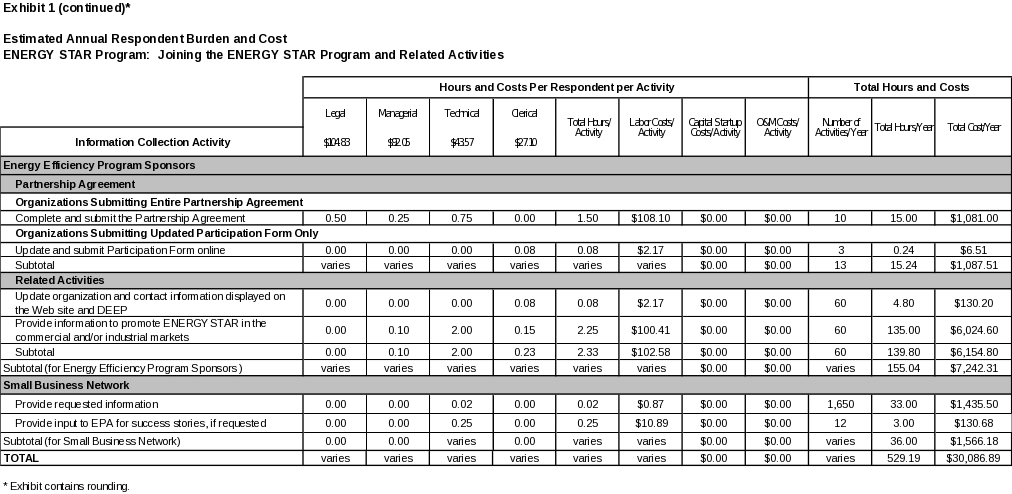
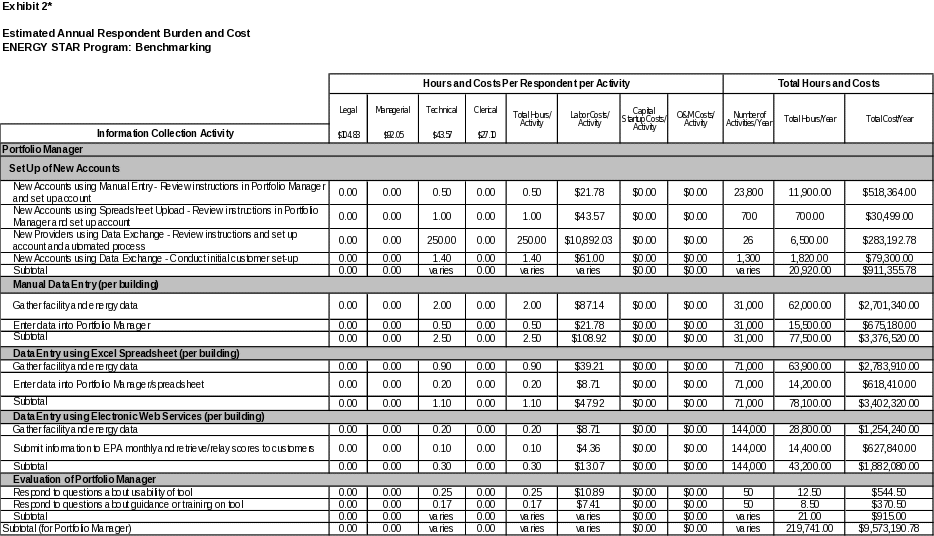
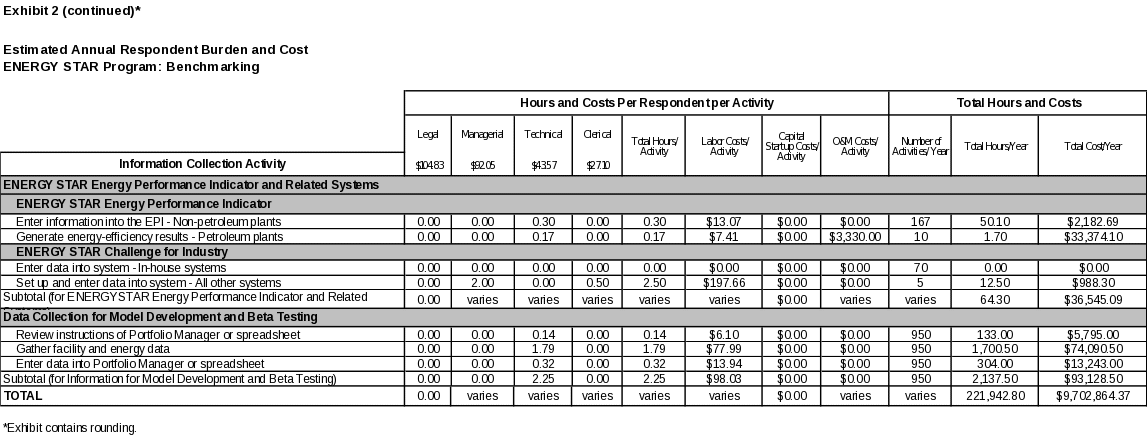
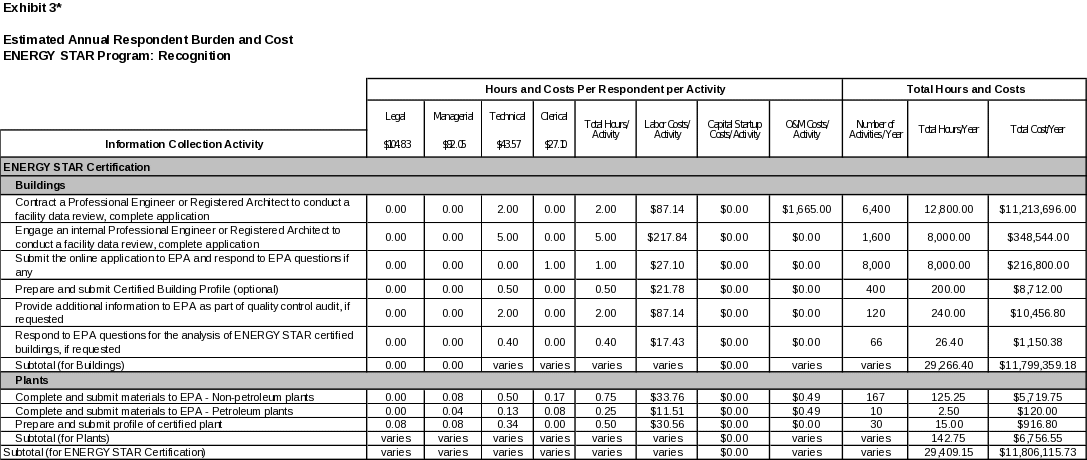

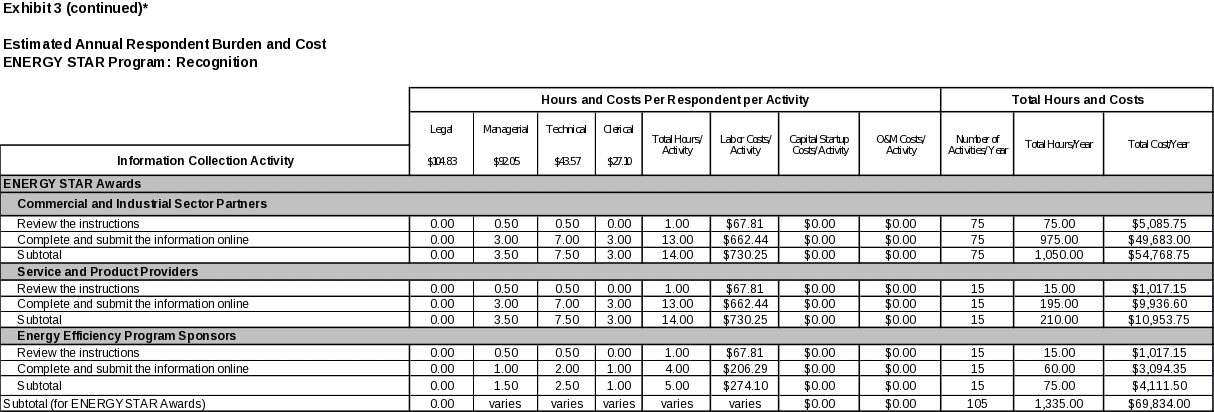
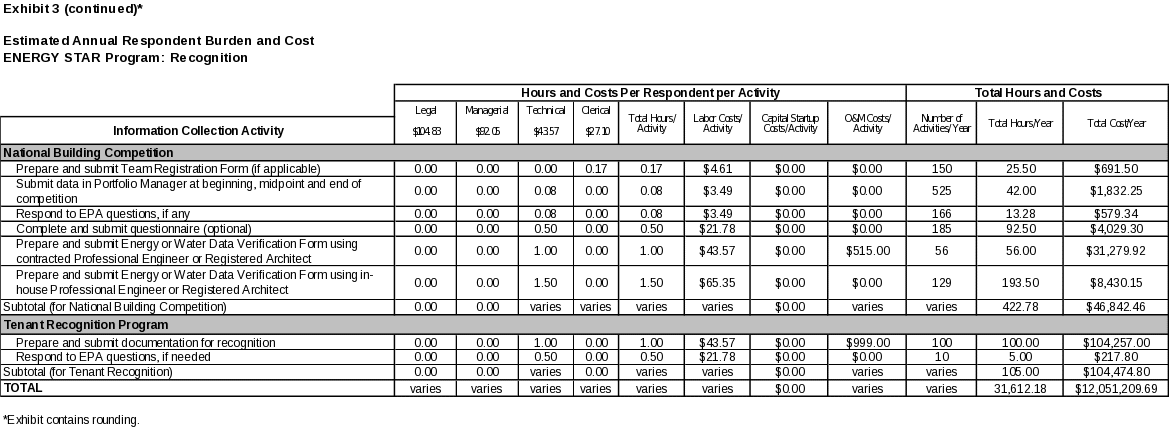
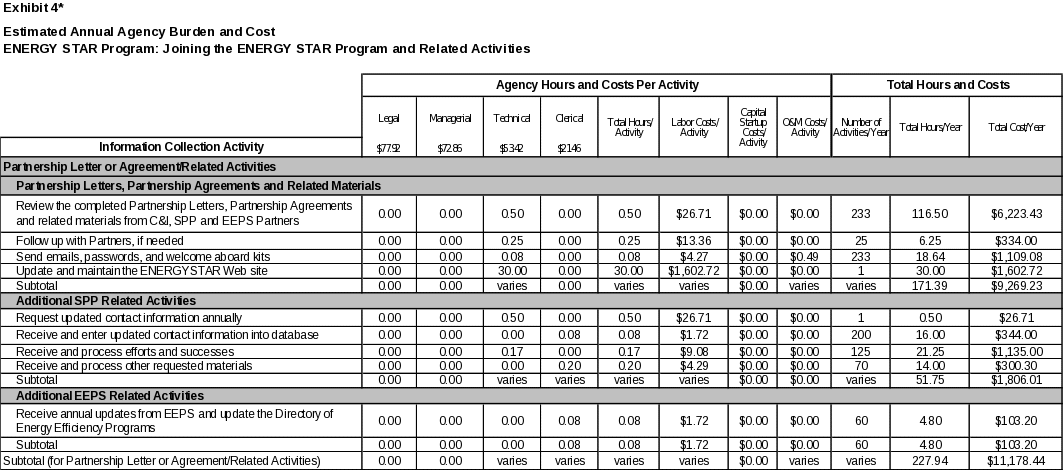


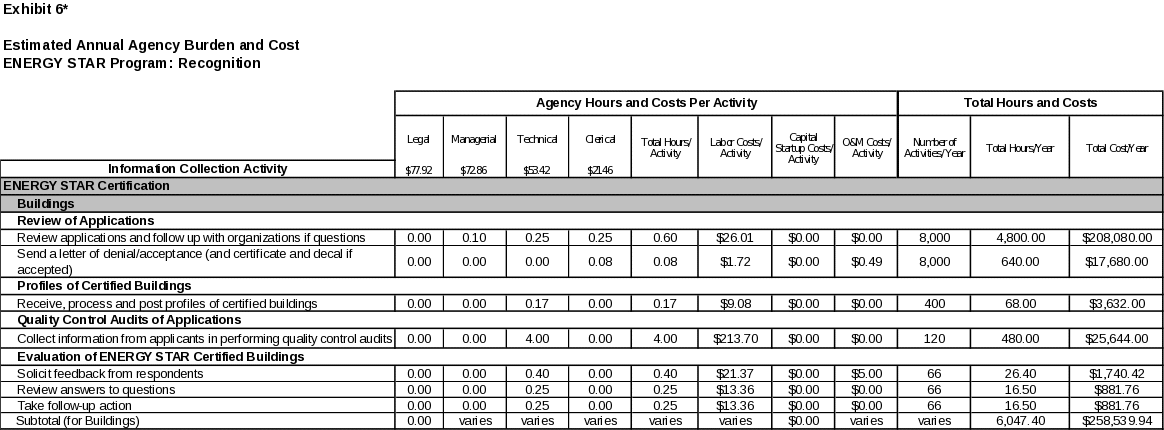

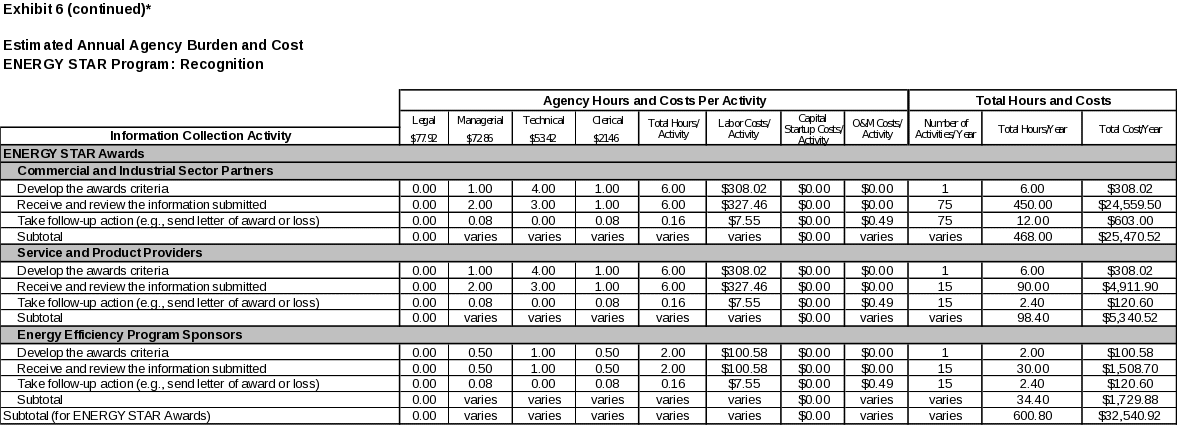
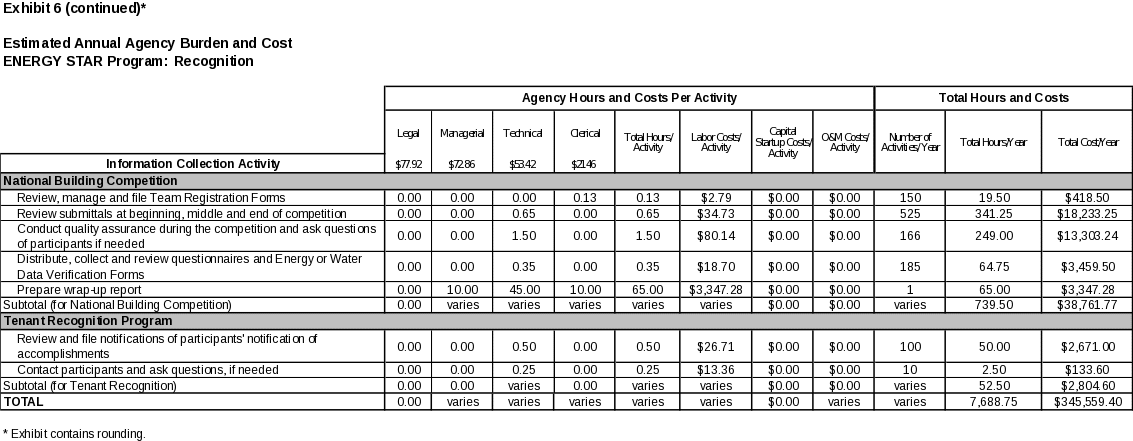
6(e) Bottom Line Burden Hours and Cost Tables
(i) Respondent Tally
As shown in Table 1, EPA estimates the total annual hour and cost burden to respondents to be 254,084 hours and $21,784,161. The burden to respondents over the three years of this ICR is estimated to be 762,252 hours and $65,352,483.

(ii) Agency Tally
As shown in Table 2, EPA estimates the total annual hour and cost burden to the Agency to be 17,840 hours and $884,051. The bottom-line burden to the Agency over the three years of this ICR is estimated to be 53,520 hours and $2,652,153.

6(f) Reasons for Change in Burden
EPA estimates a total annual respondent burden in this ICR, 1772.07, of 254,084 hours. This is an increase of 59,575 hours from the currently approved burden of 194,509 hours in ICR 1772.06.
Table 3 explains this increase. Specifically, the table presents the total annual hours estimated in ICR 1772.06 and ICR 1772.07 for each information collection (see columns 1-3). The table then compares their respective hours for each collection to derive the change in hours, and indicates whether this hour-change resulted from a program change and/or adjustment (see column 4). The table also briefly describes the program change and/or adjustment (see column 5). Finally, the table sums up all hour-changes to derive the total annual change in hours for all collections (see the bottom row of the table).
The table shows that there was a 291-hour decrease due to program changes and a 59,866-hour increase due to adjustments resulting from program growth. This resulted in a total net increase of 59,575 hours in ICR 1772.07.
The table shows that the vast majority of the increase in ICR 1772.07 resulted from EPA’s adjustments to its estimates of the public’s use of Portfolio Manager, EPA’s voluntary online tool for energy management. Based on the previous three years, EPA expects the number of participants using Portfolio Manager to increase significantly over the next three years. For example, from the currently approved ICR to this one, the number of buildings being benchmarked in Portfolio Manager is estimated to increase from 184,000 to 246,000 buildings annually.
There are a number of reasons for this projected increase. A primary reason is that state and local governments are increasingly leveraging ENERGY STAR as a way for the public to respond to rising energy costs and global warming. In addition, associations, utilities, and third-party providers are voluntarily communicating ENERGY STAR messages and promoting the use of ENERGY STAR tools and strategies in an effort to help companies reduce their energy consumption and find more environmentally friendly ways to conduct business.



6(g) Burden Statement
The public reporting and recordkeeping burden for this collection of information is estimated to average 53 minutes per response.
Burden means the total time, effort, or financial resources expended by persons to generate, maintain, retain, or disclose or provide information to or for a federal agency. This includes the time needed to review instructions; develop, acquire, install, and utilize technology and systems for the purposes of collecting, validating, and verifying information, processing and maintaining information, and disclosing and providing information; adjust the existing ways to comply with any previously applicable instructions and requirements; train personnel to be able to respond to a collection of information; search data sources; complete and review the collection of information; and transmit or otherwise disclose the information. An agency may not conduct or sponsor, and a person is not required to respond to, a collection of information unless it displays a currently valid OMB control number. The OMB control numbers for EPA's regulations are listed in 40 CFR Part 9 and 48 CFR Chapter 15.
To comment on the Agency’s need for this information, the accuracy of the provided burden estimates, and any suggested methods for minimizing respondent burden, including the use of automated collection techniques, EPA has established a public docket for this ICR under Docket ID Number EPA‑HQ‑OAR‑2006‑0407, which is available for online viewing at www.regulations.gov, or in person viewing at the Air and Radiation Docket in the EPA Docket Center (EPA/DC), WJC West Building, Room 3334, 1301 Constitution Avenue, NW, Washington, D.C. The EPA Docket Center Public Reading Room is open from 8:00 a.m. to 4:30 p.m., Monday through Friday, excluding legal holidays. The telephone number for the Reading Room is (202) 566‑1744, and the telephone number for the Air and Radiation Docket is 202‑566‑1742. An electronic version of the public docket is available at www.regulations.gov. This site can be used to submit or view public comments, access the index listing of the contents of the public docket, and to access those documents in the public docket that are available electronically. When in the system, select “search,” then key in the Docket ID Number identified above. Also, you can send comments to the Office of Information and Regulatory Affairs, Office of Management and Budget, 725 17th Street, NW, Washington, D.C. 20503, Attention: Desk Officer for EPA. Please include the EPA Docket ID Number EPA‑HQ‑OAR‑2006‑0407 in any correspondence.
1 Whereas it takes up to five hours to perform a new benchmark using manual data entry, it takes about one hour using Web Services.
2 The economic benefits for the ENERGY STAR Program represent the present value of the estimated net energy bill savings for consumers and businesses. Net energy bill savings are the difference between total consumer energy bill savings and the incremental additional investment in energy-efficient technologies and services.
3 For additional information on the ENERGY STAR Program, refer to the document, “Climate Protection Partnerships 2013 Annual Report.” It can be found at: http://www.energystar.gov/about/history/annual-reports.
4 This participant group includes businesses and other organizations in such fields as commercial and corporate real estate, education, entertainment, government, healthcare and senior care facilities, hospitality, manufacturing and industry, multifamily housing, retail, wastewater and drinking water treatment, and associations.
5 This participant group includes companies that provide energy efficiency services and/or products in the commercial and industrial markets.
6 This participant group includes regulated utilities, publicly owned utilities, and energy delivery companies; national, regional, state, or local government entities; and other organizations involved in coordinating and/or administering energy-efficiency or environmental education programs that promote ENERGY STAR, including ENERGY STAR certified commercial and industrial buildings.
7 EEPS are given the opportunity to join one or more programs within ENERGY STAR when they complete and submit their Partnership Agreement (e.g., C&I, Products). This ICR (No. 1772) consolidates the burden for all EEPS Partnership Agreements across all programs. When this ICR is renewed three years from now, EPA intends to move this consolidated burden to the Products ICR (No. 2078) because the Products program sees the greatest amount of EEPS partnering activity.
8 These documents include the following: Multifamily High Rise Developer Participation Agreement (5900-267), Multifamily High Rise Project Application (5900-266), Multifamily High Rise Testing & Verification Worksheet (5900-269), Multifamily High Rise Submittal Validation Form (5900-270), and Multifamily High Rise Performance Path Calculator (5900-268).
9 U.S. Bureau of Labor Statistics (BLS), Occupational Employment Statistics (OES), May 2014 National Occupational Employment and Wage Estimates. Available online at: http://www.bls.gov/oes/current/oes_nat.htm.
10 For purposes of this analysis, the following occupational groups of the U.S. Bureau of Labor Statistics (BLS) were used: Legal staff, SOC 23-1011, Lawyers; managerial staff, BLS SOC Code 11-1021, General and Operations Managers; technical staff, BLS SOC Code 17-3027, Mechanical Engineering Technicians; and clerical staff, BLS SOC Code 43-6014, Secretaries and Administrative Assistants, Except Legal, Medical, and Executive.
11 Bureau of Labor Statistics, Economic News Release, “Table 2. Seasonally Adjusted: Employment Cost Index for wages and salaries, by ownership, occupational group, and industry.” Available online at: http://www.bls.gov/news.release/eci.t02.htm.
12 See “Salary Table 2015-GS Incorporating the 1% General Schedule Increase Effective January 2015” available at https://www.opm.gov/policy-data-oversight/pay-leave/salaries-wages/salary-tables/pdf/2015/GS_h.pdf.
13 EEPS are given the opportunity to join one or more programs within ENERGY STAR when they complete and submit their Partnership Agreement (e.g., C&I, Products). This ICR (No. 1772) consolidates the burden for all EEPS Partnership Agreements across all programs. When this ICR is renewed three years from now, EPA intends to move this consolidated burden to the Products ICR (No. 2078) because the Products program sees the greatest amount of EEPS partnering activity.
14 Note that this ICR estimates burden based on the total annual number of buildings benchmarked (246,000), not the number of organizations using the tool. EPA believes the annual number of buildings benchmarked is more directly correlated to total burden. See Exhibit 2.
15 These documents include the following: Multifamily High Rise Developer Participation Agreement (5900-267), Multifamily High Rise Project Application (5900-266), Multifamily High Rise Testing & Verification Worksheet (5900-269), Multifamily High Rise Submittal Validation Form (5900-270), and Multifamily High Rise Performance Path Calculator (5900-268).
| File Type | application/msword |
| Author | Rasmussen, Anne |
| Last Modified By | Kerwin, Courtney |
| File Modified | 2016-02-09 |
| File Created | 2016-02-09 |
© 2025 OMB.report | Privacy Policy